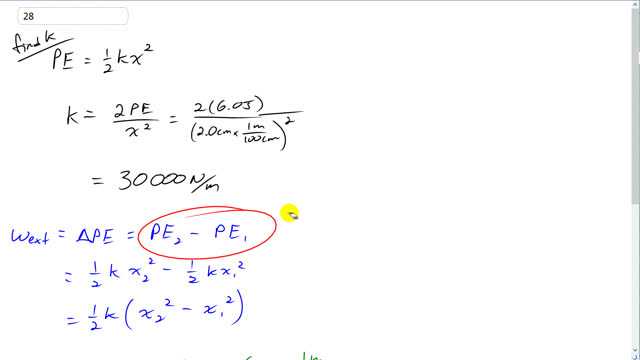
If it requires 6.0 J of work to stretch a particular spring by 2.0 cm from its equilibrium length, how much more work will be required to stretch it an additional 4.0 cm?

In order to watch this solution you need to have a subscription.
This is Giancoli Answers with Mr. Dychko. The work done, by some external force, to stretch the spring a further 4 centimeters, in addition to the 2 centimeters it's already stretched, is gonna be equal to the change in potential energy. Potential energy changes when an external net force does an amount of work to to move something, with no acceleration. Anyway. So, change in potential energy is what we are interested in here. And we'll have to figure out what k is, the spring constant, in order to figure out the change in potential energy. So the first stretching, which is only 2 centimeters, which has a potential energy of 6 joules; we can use that to calculate k and we'll multiply both sides by 2 and divide by x squared here. So we gonna get k then is 2 times the potential energy divided by the stretching, squared. So it's 2 times 6 joules divided by 2 centimeters, converted into meters by multiplying by 1 meter for every 100 centimeters, and square that on the bottom, and we get 30,000 newtons per meter as the spring constant. So the work done is gonna be the change in potential energy which is potential energy at position two minus potential energy at position one. So that's one-half k x 2 squared minus one-half k x 1 squared and we can factor out the one-half k. Now, x 2, little bit of trickiness, is 4 centimeters plus the 2 centimeters that's already stretched, for a total of 6 centimeters of stretching from equilibrium; because the x is always measured from the equlibrium position of the spring. So it's been stretched a total of 6 centimeters, converted into meters as 0.06 meters, x 1 is 0.02 meters and so the external work done to stretch it a further 4 is gonna be one-half times— the spring constant— 30,000 newtons per meter times 0.06 meters squared minus 0.02 meters squared and that gives 48 joules of work.